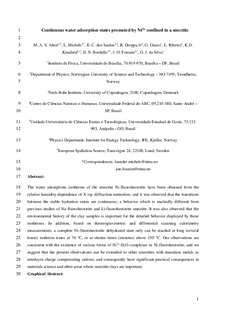| dc.contributor.author | Altoé, Mário Alberto Simonato | |
| dc.contributor.author | Michels, Leander | |
| dc.contributor.author | dos Santos, Everton | |
| dc.contributor.author | Droppa Jr., Roosevelt | |
| dc.contributor.author | Grassi, Giovanni | |
| dc.contributor.author | Ribeiro, Luciano | |
| dc.contributor.author | Knudsen, Kenneth | |
| dc.contributor.author | Bordallo, Heloisa N. | |
| dc.contributor.author | Fossum, Jon Otto | |
| dc.contributor.author | da Silva, Geraldo José | |
| dc.date.accessioned | 2017-11-02T11:38:58Z | |
| dc.date.available | 2017-11-02T11:38:58Z | |
| dc.date.created | 2016-06-24T13:57:06Z | |
| dc.date.issued | 2016 | |
| dc.identifier.citation | Applied Clay Science. 2016, 123 83-91. | nb_NO |
| dc.identifier.issn | 0169-1317 | |
| dc.identifier.uri | http://hdl.handle.net/11250/2463676 | |
| dc.description.abstract | The water adsorption isotherms of Ni-fluorohectorite have been obtained from the relative humidity dependence of X-ray diffraction intensities, and continuous transitions between the stable hydration states were observed. This behavior is significantly different from previous studies of Na-fluorohectorite and Li-fluorohectorite smectites. It was also observed that the environmental history of the clay mineral samples is important for the behavior displayed by these isotherms. In addition, based on thermogravimetric and differential scanning calorimetry measurements, it was observed that a complete Ni-fluorohectorite dehydrated state can only be reached at long times (several hours) at 70 °C, or at shorter times (minutes) above 150 °C. Our observations are consistent with the existence of various forms of Ni2+–H2O complexes in Ni-fluorohectorite, and we suggest that the present results can be extended to other smectites with transition metals as interlayer charge compensating cations, and consequently have significant practical consequences in materials science and other areas. | nb_NO |
| dc.language.iso | eng | nb_NO |
| dc.publisher | Elsevier | nb_NO |
| dc.title | Continuous water adsorption states promoted by Ni2+ confined in a synthetic smectite | nb_NO |
| dc.type | Journal article | nb_NO |
| dc.description.version | submittedVersion | nb_NO |
| dc.source.pagenumber | 83-91 | nb_NO |
| dc.source.volume | 123 | nb_NO |
| dc.source.journal | Applied Clay Science | nb_NO |
| dc.identifier.doi | 10.1016/j.clay.2016.01.012 | |
| dc.identifier.cristin | 1364062 | |
| dc.relation.project | Norges forskningsråd: 228551 | nb_NO |
| dc.relation.project | Norges forskningsråd: 234125 | nb_NO |
| dc.description.localcode | This is a submitted manuscript of an article published by Elsevier Ltd in Applied Clay Science, 4 February 2016 | nb_NO |
| cristin.unitcode | 194,66,20,0 | |
| cristin.unitname | Institutt for fysikk | |
| cristin.ispublished | true | |
| cristin.fulltext | preprint | |
| cristin.qualitycode | 1 | |
